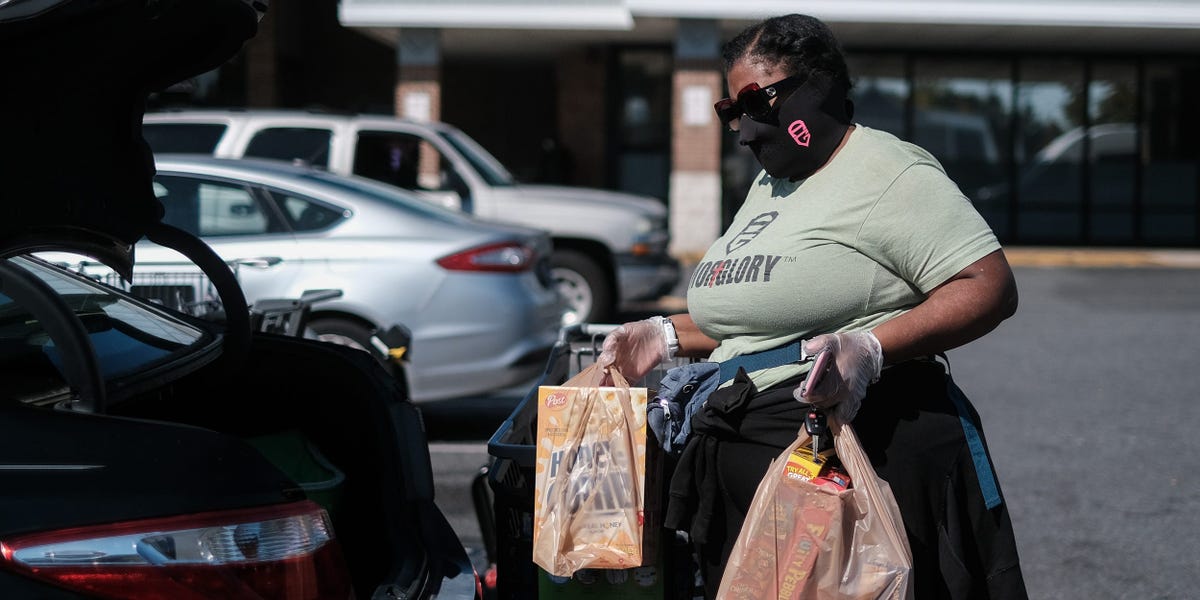- Instacart has cut its minimum base pay to $4 from $7 per order, angering many who work for the app.
- The cut makes Instacart workers more reliant on customers’ tips and claiming the best-paying orders.
- Drivers at many gig delivery services say their earnings have fallen from highs during the pandemic.
The people who deliver your groceries through Instacart just took a big pay cut.
Drivers for the delivery service are now paid a minimum of $4 per order, down from $7, according to the company and interviews and screenshots from three drivers. The cut affects base pay, or an amount that Instacart workers are guaranteed to get if they accept an order. They can earn more from customer tips.
Instacart announced the lower base pay in a July 20 blog post entitled “creating new ways to earn.” In the post, Instacart said orders that involve picking and delivering many items “may pay $10 or more” in base pay. Drivers that Insider spoke with said that they noticed the cut in their pay over the last week or so.
One driver who delivers for Instacart in Tennessee told Insider that they noticed the lower base pay on orders as early as last week. “I’ve seen it anywhere from $4.86 to $7.02,” the driver said of base pay on orders. The driver asked not to be identified, citing concerns over potential retaliation from Instacart. Insider has verified their employment.
Instacart’s blog post says that orders with at least $4 in base pay might involve “delivering a bag of chips or a pint of ice cream.” But screenshots sent to Insider by Instacart shoppers from the last few days show more complex orders. One order sent by a shopper in Indiana required driving just over a mile from the store — but only after picking up 45 items in at a grocery store for pay of just under $7.
Daniel Danker, chief product officer at Instacart, said that the company adjusted base pay to account for orders of different sizes and complexity.
“Shoppers also have full control over which batches they take, and we never penalize them for not accepting an order when it comes in,” Danker said. “With these updates, we expect average pay to stay the same for shoppers across the platform. We know that not all orders are created equal, and we want to make sure shopper earnings reflect the effort needed to fulfill each batch.”
Instacart confirmed that the change took effect last week.
The Tennessee driver, who has been working for Instacart for six years, said that they made $200 delivering for the service last week — “the worst I’ve had,” according to the driver. “When I first started Instacart, it was easy to make $1,000 a week” by working up to 30 hours.
Alexia Hudson, who lives in South Carolina and delivers for Instacart around the Charlotte metro area, told Insider that she’s also noticed the lower base pay in recent orders. Over the last week, the only shopping trips she’s made through Instacart that have paid more than $7 have either been orders with dozens of items or what Instacart calls “batches” — multiple orders that the service groups together for a shopper to fill on the same trip.
Lower batch pay is just the latest hit to Hudson’s income through Instacart. She told Insider that her earnings started to dip this spring: She noticed fewer orders available and more people trying to claim them.
“Since the pay has gone down, it’s not worth it anymore,” she said, adding that she’s looking for a full-time job to replace her delivery work.
Lower base pay means more reliance on tips
Both Hudson and the driver in Tennessee said that the base pay cut makes customers’ tips a more important source of income. “I used to serve tables back in the day,” the Tennessee driver said, comparing working for Instacart to a job at a restaurant where employees are only paid a few dollars an hour and rely on gratuities for most of their income. “It’s like that. You’d rely heavily on those tips.”
Sergio Avedian, a spokesman for The Rideshare Guy blog and YouTube channel, said Instacart’s base pay slashing is part of a growing trend among many delivery and rideshare apps in their “rush” to reach profitability. “It is happening everywhere. They’re all doing it,” said Avedian, an Uber Eats and DoorDash driver. “They have finally figured out how to arbitrage the power of the app.”
The trend for apps, he said, is charging as much as they can to the passenger and “paying as little as they can to the driver.”
That’s been the case for Avedian. He makes food deliveries for DoorDash and Uber in Los Angeles. He said his average base pay is about $1 per mile — 50% less than during the height of the pandemic when earnings surged due to demand.
Lower earnings are hitting delivery drivers as inflation has pushed prices for everything higher, from gas to food. “Especially when things are costing more, you should be giving increases, not decreases,” the Instacart driver in Tennessee said.
Do you work for Instacart and have a story idea to share? Write to this reporter at [email protected] or via encrypted messaging app Signal at 808-854-4501.
Read the full article here





